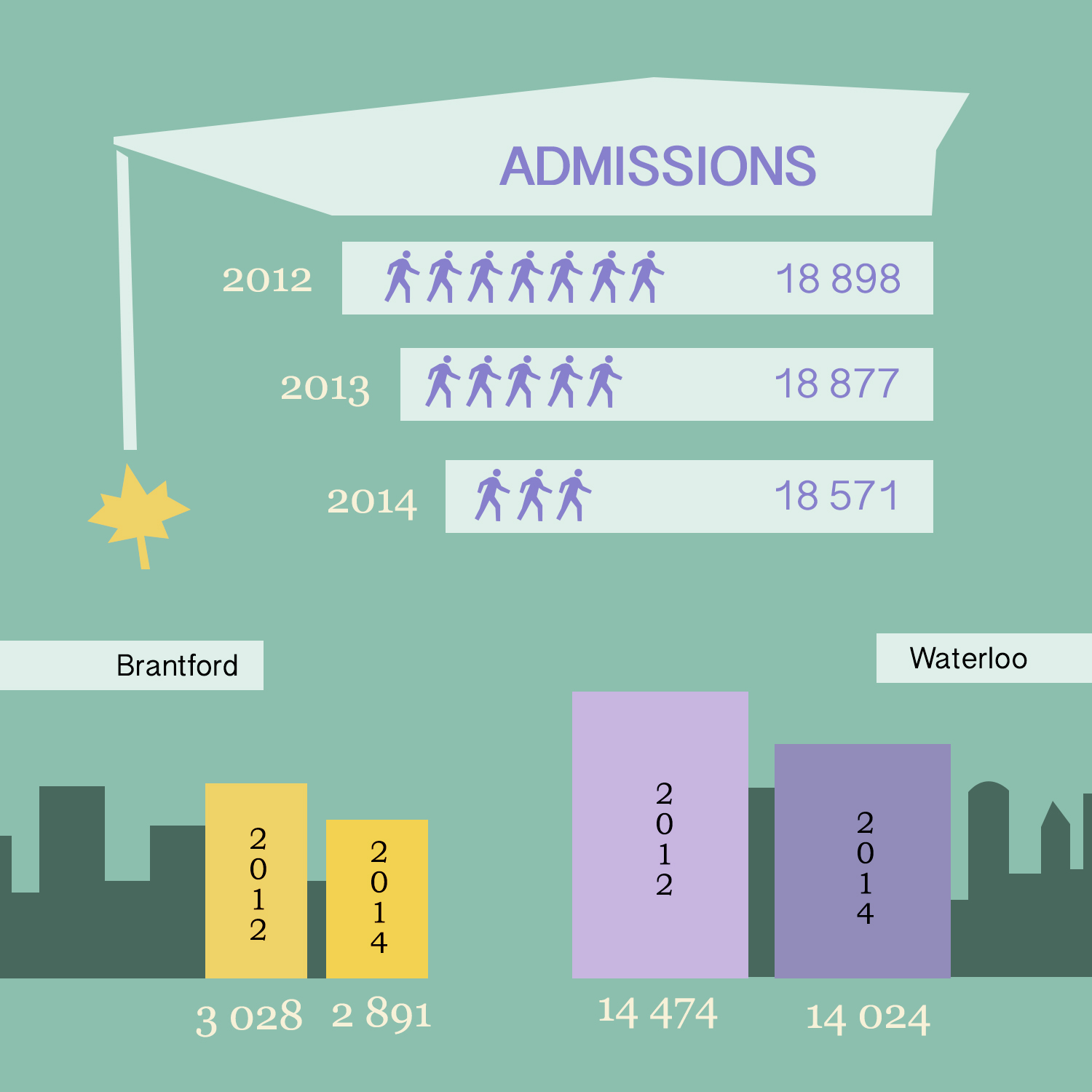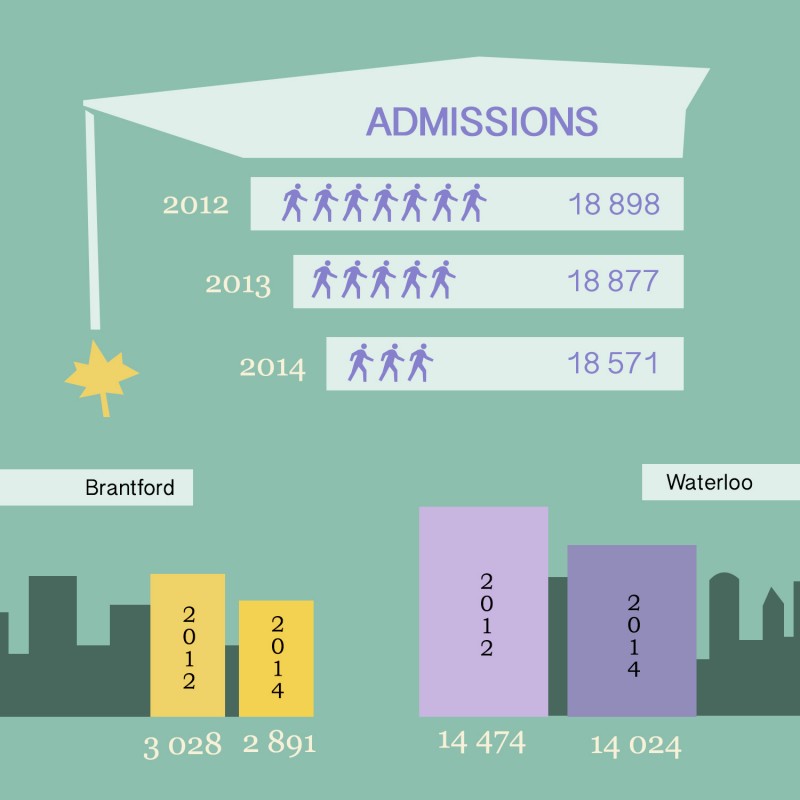WLU enrolment down

As of Nov. 1, admissions reported 287 less students enrolled at Laurier in 2014 than 2013, raising concerns

The finalized numbers are in and reveal that Wilfrid Laurier University as a whole experienced a drop in enrolment this year. According to Ruth MacNeil, acting university registrar, the target was to intake 4,474 new students this year. As of November 2014, Laurier had a total of 4,024 new first-year students enrolled.
Concern in terms of enrolment numbers for 2014 arose at the beginning of the summer, around the deadline for high school students to confirm their acceptance to Laurier. At this point, there was close to 500 fewer students enrolled at Laurier as compared to 2013.
As of September, enrolment had increased, closing the gap between the 2013 and 2014 numbers. In September 2013, 19,108 undergraduate students were enrolled.
In September 2014, this number was 18,821 — a difference of 287 students. MacNeil said this was largely due to efforts by recruitment and admissions over the summer to close the gap.
“We saw more students committing between June and the end of August and other schools in Ontario would normally see a decrease,” said MacNeil.
After this point, the registrar’s office looks at attrition rates between September and November from year to year.
“Overall, there’s always an attrition rate each year with the university, and we always look to make sure the attrition rate is acceptable,” she said.
From September 2014 to November 2014, undergraduate enrolment dropped from 18,821 students to 18,571 students — a difference of 250 students. From September 2013 to November 2013, undergraduate enrolment dropped from 19,108 students to 18,871 — a difference of 237 students.
As of Nov. 1, the final number of undergraduate students enrolled at Laurier in 2014 was 18,571. In 2013, this number was 18,877, which is a difference of 306 students.
“I think it was expected,” said MacNeil, in terms of the registrar report’s reception at Senate, where it was presented on Nov. 26.
“There were some questions, but mostly about the numbers and whatnot.”
She continued that the numbers were no surprise since most Senate members were aware of the situation in September.
“There’s never a positive reaction because you’re reporting numbers going down, but it was very much expected.”
MacNeil explained that the focus now is on the next recruitment cycle as well as ensuring retention rates are doing well.
Jennifer Casey, acting vice-president of enrolment services, has been taking on the task of trying to improve enrolment numbers for next year.
“I’ve been spending a lot of time trying to educate the community on strategic enrolment management and how it’s an institutional-wide initiative,” said Casey.
Casey said strategic enrolment management involves looking closely at data from the marketplace.
“It’s well understood that the 15-24 age group is on the decline and will be through until the mid-2020s,” said Casey in terms of enrolment at universities.
The plan, then, is to help all facets of the university understand the role they play in enrolment.
Casey said the numbers from fall recruitment activities have been positive.
When recruitment teams visit high schools, students provide them with their name and what program they are interested in receiving more information about. This year, recruitment collected 19 per cent more names.
Open houses on the Waterloo and Brantford campuses had increased attendance: Waterloo increased by 41 per cent, with tours up 21 per cent, and Brantford increased by 31 per cent, with hour-long tours increasing 16 per cent. Lastly, at the Ontario Universities Fair, 44 per cent more people sat in on the Laurier presentation.
With university applications due on Jan. 14, recruitment and admissions is now moving into the conversion period where applications are received and reviewed and acceptances are sent out.
“Everybody has a role to play in promoting the institution, promoting the programs, promoting the exceptional student engaged environment that we have,” Casey said. “I can’t control if there are surprises or not, but if everybody understands what our objectives are, everybody has been educated and we’re all working together with data-driven strategies then I’ll know we have done the best we could as an institution.”
Also as a result of the anticipated decrease in enrolment in post-secondary studies by Ontario high school students, Laurier will be focusing its efforts on recruiting from the smaller pool of applicants — international students, mature students, out of province students and university and college transfers.
“There’s a lot of growth in that area, understandably,” said Casey.
MacNeil said it is difficult to tell what kind of impact the decrease in enrolment will have on the university.
“There are some town hall meetings in the near future where finance will be bringing forward information to the university environment in terms of how this will play out from a budget perspective.”
Casey said they are looking to be realistic in their targets for enrolment numbers in 2015.
“We know the demographics are continuing to shrink. There will be fewer high school students applying to Ontario universities this fall, we know that.”
She continued that she has been meeting with Jim Butler, vice-president of finance and administration, to ensure the financial models for the university are based on realistic targets of admissions.
“Institutionally, we’re taking a very strategic approach,” Casey said.
–With files from Shelby Blackley


